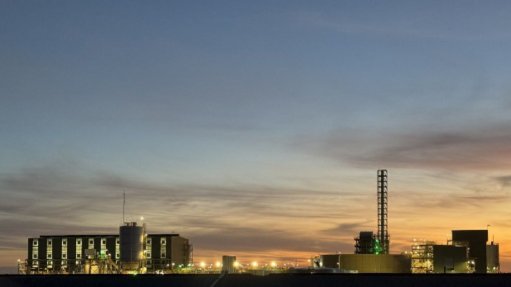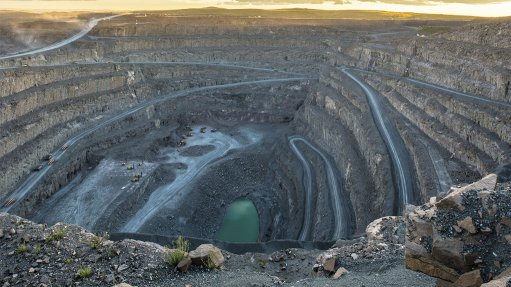Advances in in-line analyser technologies provide accuracy, consistency and certainty
This article has been supplied as a media statement and is not written by Creamer Media. It may be available only for a limited time on this website.
A significant benefit of in-line and on-line analysers is their ability to provide the continuous control needed to operate a mineral processing plant at optimal levels by obtaining critical information at extremely short and consistent intervals.
These analysers are fully automated and eliminate human error to provide significantly higher levels of accuracy, consistency and certainty than what are possible with off-line and at-line technologies.
Off-line analysis is suited to applications that require a variety of analytical methods.
Many hours are spent by technically trained personnel in preparing, measuring and evaluating the various samples, using specialist laboratory equipment in a controlled environment.
Considering that material properties can change from when samples have been collected and by the time that the results of the evaluation have been received by the plant operators, this process inhibits continuous control.
At-line analysis is used for samples from various locations within the plant during a shift.
They offer a faster and more efficient alternative than their off-line counterparts and are, therefore, able to reduce workloads at the laboratory to improve turnaround times.
At-line instrumentation is usually centrally located within the processing area to allow ease of operation, because the controller is also tasked with collecting the samples and loading them for testing.
Conversely, in- and on-line technologies export the results directly to control external devices, such as the pump or valves, as part of the analysis sequence, and are able to monitor between several concentrations of production-critical analytes.
The speed at which information is supplied makes in-line/on-line analysis suitable for feed-forward control. This means that the instrumentation is suited to process automation as opposed to only monitoring and simple quality assurance functions.
A major weakness of on-line analyser systems is their sampling lines that feed the analytical system. It is claimed that up to 95% of the problems associated with these systems are related to flow.
Their accuracy may also be impeded if consideration is not given to the way in which the samples are collected and handled in the quest for a single reference analytical value.
This is considering that samples are presented to a single analyser after travelling over large distances through launders and pipes.
In-line analysers are installed directly into the process stream and, therefore, do not require additional engineering, such as the installation of bypass lines with their associated risk of clogging and possible sample bias.
This means that they present a representation of the actual process stream without the further bias associated with take-off points and sampling systems.
Blue Cube Systems’ (BCS) in-line technology can be placed in process lines of varying diameters and can be used in most plant environments.
This technology is based on diffuse-reflective spectroscopy, which is also a safer alternative to potentially harmful nuclear sources or X-ray devices.
The BCS Mineral Quantifier In-line (MQi) Slurry Analyser has been deployed by numerous process plants to ensure fast, accurate and reliable real-time measurement of the elemental and mineral composition of plant feed, tailing and concentrate slurries.
The MQi Slurry Analyser provides a continuous signal that is updated every 15 seconds to ensure stabilisation and, therefore, precise process control. This improves the recovery and grade by automating the level, air and reagent set points in typical flotation circuits.
The MQi Slurry Analyser has been used to measure light elements and minerals, such as sulphide, sulphur and bone phosphate of lime.
Reductions in upfront capital costs are achievable by being able to measure up to seven streams using the MQi multi-stream slurry analyser and is complemented by the analyser’s small footprint, which eliminates the need for additional infrastructure.
Another significant benefit of on-line and in-line systems is the important role that they can play in assisting mines to create safer operating environments for employees by mitigating human exposure to potentially toxic reagents when collecting and handling samples.
The MQi has a dedicated pneumatic sampler takes the required calibration samples, operated by BCS’ automated sampling software which reduces the the number of samples required.
Samples are deposited in a dedicated sampling cabinet which further increases safety and reduces costs and prevent samples from being contaminated.
It is evident that major strides have been, and continue to be made in measurement and control engineering, and that the ongoing quest for automation makes in-line equipment, such as the BCS MQi Slurry Analyser, the ideal solution for control and automation engineers.
Comments
Press Office
Announcements
What's On
Subscribe to improve your user experience...
Option 1 (equivalent of R125 a month):
Receive a weekly copy of Creamer Media's Engineering News & Mining Weekly magazine
(print copy for those in South Africa and e-magazine for those outside of South Africa)
Receive daily email newsletters
Access to full search results
Access archive of magazine back copies
Access to Projects in Progress
Access to ONE Research Report of your choice in PDF format
Option 2 (equivalent of R375 a month):
All benefits from Option 1
PLUS
Access to Creamer Media's Research Channel Africa for ALL Research Reports, in PDF format, on various industrial and mining sectors
including Electricity; Water; Energy Transition; Hydrogen; Roads, Rail and Ports; Coal; Gold; Platinum; Battery Metals; etc.
Already a subscriber?
Forgotten your password?
Receive weekly copy of Creamer Media's Engineering News & Mining Weekly magazine (print copy for those in South Africa and e-magazine for those outside of South Africa)
➕
Recieve daily email newsletters
➕
Access to full search results
➕
Access archive of magazine back copies
➕
Access to Projects in Progress
➕
Access to ONE Research Report of your choice in PDF format
RESEARCH CHANNEL AFRICA
R4500 (equivalent of R375 a month)
SUBSCRIBEAll benefits from Option 1
➕
Access to Creamer Media's Research Channel Africa for ALL Research Reports on various industrial and mining sectors, in PDF format, including on:
Electricity
➕
Water
➕
Energy Transition
➕
Hydrogen
➕
Roads, Rail and Ports
➕
Coal
➕
Gold
➕
Platinum
➕
Battery Metals
➕
etc.
Receive all benefits from Option 1 or Option 2 delivered to numerous people at your company
➕
Multiple User names and Passwords for simultaneous log-ins
➕
Intranet integration access to all in your organisation


















